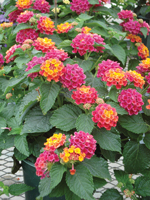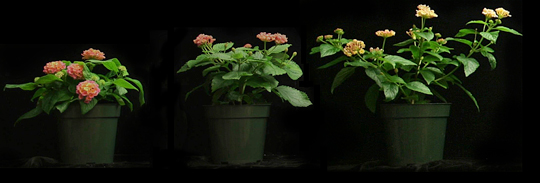2/26/2015
Controlling Lantana Growth
Christopher J. Currey, Kellie J. Walters & Kenneth G. McCabe

In the middle of summer, when the hot, dry days are taking their toll on plants in garden beds and containers on the patio, what plants are left standing? Few and far between! However, one of the most prominent “stars of the summer” is lantana. It’s a great plant in landscapes and containers, providing a profusion of color throughout the dog days of summer.
While lantana is a great plant for the landscape, there are several challenges associated with producing lantana in your greenhouse. First, cuttings can be very sensitive to ethylene and must be stuck as quickly as possible upon arrival in the greenhouse. Next, in order to produce a finished plant with good form, a pinch or two should be used to promote branching. Once these plants are established in containers, controlling the size of some cultivars can also be a big challenge.
There are several ways to control growth of containerized annuals and perennials, including negative DIF, reducing fertilizer applications and restricting irrigation. While these are all useful techniques, it can be hard to use them when your greenhouse is filled with dozens of different species and cultivars. Therefore, PGRs can be applied to small groups of plants to provide species- and cultivar-specific growth control for containerized bedding plants in a greenhouse full of diverse plant material. A number of commercial recommendations for using PGRs to control growth of lantana suggest using spray applications. However, applying PGRs using substrate drenches generally results in more uniform and long-lasting control.
We’ve found little information about using PGR drenches to control the growth of containerized lantana. Therefore, the objective of our research was to evaluate the effectiveness of PGR drenches with different active ingredients on the growth of containerized, greenhouse-grown lantana.
Materials and methods
Unrooted cuttings of Little Lucky Peach Glow, Lucky Peach and Landmark Peach Sunrise Lantana were received at Iowa State University in Ames. Cuttings were rooted in 105-cell plug trays filled with a substrate comprised of (by volume) 50% coarse perlite and 50% commercial soilless substrate and placed under mist in the greenhouse. Four weeks after placing cuttings into trays for rooting, fully rooted cuttings were individually transplanted into 4.5-in. round plastic containers filled with a commercial, soilless growing substrate comprised of sphagnum peat moss and perlite (Sunshine Mix # 1; Sun Gro Horticulture).
Once the roots of lantana cuttings reached the 4.5-in. container wall, 14 days after transplanting we applied the PGR treatments. Two fl. oz. of solution containing 0 (control), 0.5, 1.0, 2.0 or 4.0 ppm solutions of ancymidol (Abide; Fine Americas), flurprimidol (Topflor; SePRO), paclobutrazol (Piccolo; Fine Americas) or uniconazole (Concise; Fine Americas) were applied to the surface of the growing substrate.
Plants were grown in a glass-glazed greenhouse with radiant hot water heating, fan-and-pad cooling and supplemental lighting from high-pressure sodium lamps when ambient light levels were low. Plants were irrigated as needed using water supplemented with a complete, balanced, water-soluble fertilizer providing 300 ppm nitrogen alternating with clear water.
Six weeks after applying PGR drenches, we collected data. The height of the plant from the surface of the growing substrate to the top of the plant canopy and the widths at the widest point of the plant and perpendicular from that widest point were recorded. The Growth Index (GI), an integrated measurement of plant size incorporating the height and widths of plants, was calculated. Shoots were cut at the surface of the growing substrate, individually placed into a paper bag and placed in a drying oven for three days, after which time shoots were weighed and the dry mass was recorded. First flowering was not recorded because flowering began shortly after PGR treatments.
Pictured Below: Figure 1. The three different cultivars of lantana used in this study vary in their natural growth habit. From left to right: Little Lucky, Lucky and Landmark.

What we saw
First, there was clear variation in plant height, width and GI among the cultivars used in this study (Figure 1). Little Lucky Peach Glow, Lucky Peach and Landmark Peach Sunrise are all representative colors of series bred to produce plants of different sizes that may be utilized for different purposes. For example, the smaller Little Lucky is a more compact lantana that’s well-suited to container culture, such as hanging baskets or patio containers.
On the other hand, the Landmark series is a larger-growing series that was bred for landscape performance. The Lucky series is an intermediate-sized series, somewhere between the Little Lucky and Landmark series that can be used in either containers or landscapes.
In addition to the differences among lantana cultivars, we found variation in activity among the different PGRs applied. When looking at the range in concentrations used in our experiment (0 to 4 ppm), ancymidol generally had the lowest activity across the four PGRs applied. Alternatively, flurprimidol and uniconazole had the strongest effect on the height and width of lantana across all three cultivars. Paclobutrazol could be considered as having somewhat of an intermediate effect on growth when compared to similar concentrations of the other PGRs. Paclobutrazol had more activity when compared to ancymidol, but not quite as much when compared to similar concentration of flurprimidol and uniconazole.
Our results are reinforcing some well-understood relationships. When these active ingredients are listed in order, from lower activity to higher activity, we would generally think ancymidol, paclobutrazol, then uniconazole—whether it’s a spray or drench. Flurprimidol is a bit different. When used as a spray, it has activity comparable to paclobutrazol, whereas when it’s applied as a drench the activity is comparable to uniconazole. Our results support classifying the activity of flurprimidol as comparable to uniconazaole, not paclobutrazol, when applied as a drench to lantana.
So by now you may be wondering which PGR you should apply and at what concentration. The answer is: it depends! First, it’s going to depend on the cultivar. If you’re growing a compact cultivar, PGRs may not be necessary. Our Little Lucky Peach Glow Lantana that received no PGR treatment finished with a great, compact size. If you’re growing an intermediate-sized lantana, the amount of growth control required will depend on how much regulation of plant size you’re looking for.
For a 4- or 4.5-in. container, drenches containing 2 to 4 ppm paclobutrazol or 1 to 2 ppm flurprimidol or uniconazole may do the trick. For more vigorous lantana cultivars, 2 ppm flurprimidol or uniconazole resulted in a nice, compact plant. While stronger concentrations also produced plants that looked good in the container, these more vigorous cultivars will likely be planted into landscapes where consumers will want them to “take off.” As a result, you’ll want to use concentrations that will “hold” growth, not “stop” it!
Conclusions and future directions
When you’re evaluating containerized lantana in your greenhouse this spring and wondering how to control the size, consider using PGR drenches. However, before selecting an active ingredient and a concentration, evaluate the growth habit of the cultivars you’re producing. Are they a large and vigorous cultivar, a smaller cultivar with modest vigor or somewhere in-between? The PGR concentrations used in our work are a good range for the different active ingredients we used. However, always be sure to perform in-house trials to evaluate the effectiveness of PGR treatments with your cultivars under your individual growing conditions to see what will be the most effective treatment.
GT
Christopher J. Currey (ccurrey@iastate.edu) is an Assistant Professor of Horticulture specializing in greenhouse and controlled-environment crop production, Kellie J. Walters (kelliew@iastate.edu) is a graduate student and Kenneth G. McCabe (kgmccabe@iastate.edu) is a research associate in the Department of Horticulture. The authors would like to thank Ball Horticultural Company for plant material and Fine Americas and SePRO for PGRs.